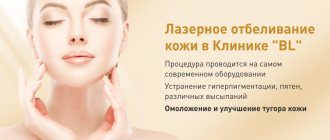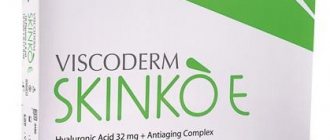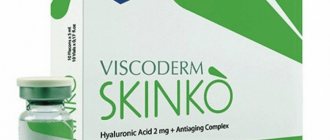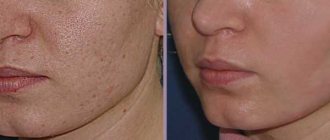- Consultation with a cosmetologist . Here, the doctor determines whether placentotherapy is right for you or whether it is better to undergo a course of other procedures. If the doctor has doubts about your contraindications for injections, he will order laboratory tests for you.
- The administration of the placental drug itself can be carried out intramuscularly or intravenously. Laennec and Kurasen can also be injected into the dermis, similar to the mesotherapy procedure. The method of drug delivery to the body depends on the patient’s goals and indications. The injection method is chosen by the doctor.
- Placenta injections are tolerated comfortably. Anesthesia is usually not required. At your request, if you are afraid of injections, we can offer you light premedication before the procedure. The doctors at the Marina Ryabus clinic do everything to ensure that your visit to the cosmetologist is as pleasant as possible and leaves a good impression.
Stages of the procedure
- Cleanses the skin of makeup and impurities.
- Antiseptic treatment.
- Opening the drug.
- Microinjections of the drug over the entire area of the face. Drops of blood or small hematomas may appear at the puncture sites - this depends on individual characteristics.
- Antiseptic treatment.
- Applying a restorative composition to the skin.
- Getting recommendations from a doctor.
MIGUNOVA ANASTASIA ANDREEVNA
Cosmetologist
Initial consultation: RUB 4,500
Make an appointment with a doctor Instagram
VYATKINA IRINA SERGEEVNA
Gynecologist-endocrinologist
Initial consultation: RUB 9,500
Make an appointment with a doctor Instagram
KALININA EKATERINA ALEXANDROVNA
Cosmetologist
Initial consultation: RUB 4,500
Make an appointment with a doctor Instagram
KOZLOVA EKATERINA NIKOLAEVNA
Gynecologist-endocrinologist, oncologist
Initial consultation: RUB 6,000
Make an appointment with a doctor Instagram
Placental drugs in the correction of hyperpigmentation
The problem of hyperpigmentation includes skin conditions that are associated with excessive accumulation of melanin. In accordance with ICD-10, pigmentation disorders are classified as “Diseases of the skin and subcutaneous tissue (L00-L99)” (see Table 1)
.
| Table 1. Other pigmentation disorders (L81) |
| L81.0 Post-inflammatory hyperpigmentation |
| L81.1 Chloasma |
| L81.2 Freckles |
| L81.3 Coffee stains |
| L81.4 Other melanin hyperpigmentation |
| Lentigo |
| L81.5 Leucoderma, not elsewhere classified |
| L81.6 Other disorders associated with decreased melanin production |
| L81.7 Pigmented red dermatosis |
| Angioma creeping |
| L81.8 Other specified pigmentation disorders |
| Iron pigmentation |
| Tattoo pigmentation |
| L81.9 Pigmentation disorder |
| Unspecified |
Much remains unclear about the causes of hyperpigmentation.
Bychkova Natalya Yurievna, Ph.D. Federal State Budgetary Educational Institution of Higher Education IGMA of the Ministry of Health of Russia, chief freelance expert of the Ministry of Health of the Urals in cosmetology, president of the Association “Section of Aesthetic Medicine”, in the article “Skin Dyschromia: Issues of Therapy” writes: “Disorders of skin pigmentation (dyschromia) are a pressing problem, their share is about 10% of all calls to cosmetologists. Congenital pigmentation is controlled by genotype; acquired - determined by the influence of external or internal factors (insolation, radiation, hormonal status, deficiency or excess of vitamins and microelements, bad habits), and also accompanies some diseases. In pathology of the melanocytic system, changes can be both qualitative and quantitative. In quantitative cases, the clinical picture corresponds to skin dyschromia, and in qualitative cases, neoplasms appear. Melanogenesis is one of the key processes of homeostasis, which is regulated by hormones of the pituitary gland, hypothalamus, adrenal cortex, male and female gonads, as well as ultraviolet radiation and acetylcholine. Ultraviolet increases the functional activity of melanocytes, stimulates increased processivity and the production of melanin, which leads to its accumulation in the cell with further transport to keratinocytes. A number of external factors can lead to increased pigmentation. Thus, a stimulating effect on melanocytes of serial exposure to infrared and x-ray radiation has been established. The process of melanin formation is affected by an excess or deficiency of vitamins in the skin: increased B1 and B2 or deficiency of A, C, PP stimulate melanogenesis. Hyperpigmentation can appear at any age, but it is considered a characteristic sign of premature aging.”
It is worth noting that it is an established fact that localized and irregular production of melanin by melanocytes in the basal layer of the epidermis or retention of melanin in the epidermis due to aberrant epidermal turnover, or both, play a role in the occurrence of skin hyperpigmentation (see Ando et al. 2010 for more details).
.
Therefore, to correct melanosis, it is important to reduce excess melanin production and promote its removal from the epidermis.
How do placental drugs act on melanogenesis?
Let's consider the scientific basis.
Previously, the main source for obtaining placenta extract was the afterbirth of cattle. However, due to the risk of mad cow disease, porcine derivatives of placental extracts, which have been well studied, are now used.
In 2016, it was found that treatment with pig placenta extract reduces melanin content and suppresses tyrosinase activity in melan-A melanocytes, a recently discovered marker of melanoma. And this ability may also have a certain brightening effect (Lee Ji-Eun et al. 2016)
.
Another source is the human placenta, as we already mentioned above. For example, JBP, which produces the placental drug CURACEN, manufactures it in its own factories according to the strictest Japanese pharmaceutical standards under the supervision of the Japanese Ministry of Health.
Placental drug CURACEN obtained from human placenta hydrolyzate includes a number of active ingredients, which include low molecular weight regulatory peptides
(palmitoyl tripeptide 3; copper tripeptide 1; palmitoyl tripeptide 5; hexapeptide 11; palmitoyl tripeptide 1; tripeptide 30; tetrapeptide 7; acetyl tetrapeptide 2; acetyl tetrapeptide 5),
active centers of growth factors
(BFGF - basic fibroblast growth factor; AFGF - acidic fibroblast growth factor ; VEGF – vascular endothelial growth factor; KGF – keratinocyte growth factor),
native hyaluronic acid and amino acids
(leucine; lysine; threonine; proline; phenylalanine; histidine; arginine; serine).
Most of these components have proven effectiveness in suppressing melanogenesis.
Thus, activation of growth factors leads to a decrease in solar lentigo.
It is known that keratinocytes and fibroblasts synthesize growth factors and cytokines. Solar lentigo is characterized by the appearance of hyperpigmented skin lesions on photodamaged areas of the skin. And if you influence growth factors, you can reduce the phenomenon of hyperpigmentation, as Italian scientists found (Kovacs et al. 2010)
.
Idiopathic hypomelanosis (IGH) is another pigment disorder that occurs due to decreased melanocyte function due to photosensitivity or persistent skin irritation. Scientists from India tested placenta extract combined with phenol to reduce the manifestations of IGH (Gupta et al. 2016)
.
Forty patients were divided into two groups. In one, they used spot peeling on the affected area with 88% phenol, and in the second group they also added placenta extract. The results showed that the effectiveness of combination therapy using a placental drug was much higher.
Hyperpigmentation caused by burns can also be easily corrected with the use of placental drugs. This occurs by reducing and inactivating the synthesis of the important enzyme tyrosinase, which is involved in the production of melanin.
Korean scientists administered intradermal injections of placenta hydrolyzate to ten patients. Injections were given weekly for about a month (Choi et al. 2009)
. Control measurements of spots and their evaluation showed that after injections the changes compared to the beginning of treatment were statistically significant (p <0.05).
Various amino acids and minerals, found in high concentrations in placental preparations, effectively inhibit melanin synthesis and enhance its removal from the epidermis by stimulating cellular metabolism.
But one important fact established in research must also be taken into account: the effect of placenta extract is due not only to the activation of growth factors, but also to the effect on lipids. Lipids, especially sphingolipids, are another regulator of cellular activity. Human placental hydrolyzate has been found to be a strong inducer of pigmentation at the transcriptional and translational levels and can increase melanin synthesis by enhancing the expression of the tyrosinase gene (Mallick et al. 2005)
.
The doctor should remember this.
Clinical examples of the use of placental drugs in the correction of hyperpigmentation
Rice. 1.
Dynamics of action of the placental drug CURACEN on the patient’s facial skin. Photo courtesy of E. I. Gubanova “Study of the rejuvenating and brightening capabilities of the drug CURACEN in the correction of involutional changes in the skin of the face and hands with signs of photodamage.”
Rice. 2.
Clinical regression of areas of hypermelanosis after monotherapy with the placental drug CURACEN (before/after). Photos courtesy of N. Yu. Bychkova.
Rice. 3.
Post-inflammatory pigmentation after monotherapy with placental drug CURACEN (before/after). Photos courtesy of N. Yu. Bychkova.
Indications and contraindications
Indications:
- sagging, dehydrated skin;
- wrinkles;
- wide pores;
- tendency to rashes;
- peeling, irritation;
- vascular network;
- dark spots;
- acne scars;
- oily skin;
- skin damage due to improper laser resurfacing or chemical peeling.
Contraindications:
- pregnancy, lactation;
- under 18 years of age (strictly);
- age after 60 years;
- menstruation;
- inflammatory processes;
- diseases of internal organs;
- cold;
- oncology;
- diabetes;
- mental illness;
- tendency to the appearance of keloid scars.
A complete list of contraindications will be provided to you by your doctor during a face-to-face consultation at the clinic. If it is impossible to carry out placentotherapy, you will be offered another injection or hardware method of eliminating deficiencies and prolonging youth.
Placental therapy
The effectiveness of placental cosmetology
Placental cosmetology products can be used for:
- skin rejuvenation (improving skin quality, increasing its elasticity and firmness, reducing wrinkles and pigmentation);
- treatment of problem skin (acne, inflammatory processes);
- hair treatment (stimulating hair growth, restoring thickness and shine, normalizing hair structure).
The drugs are administered by injection.
Make an appointment Do not self-medicate. Contact our specialists who will correctly diagnose and prescribe treatment.
Make an appointment
Possible side effects
After the procedure, there may be bruising at the injection sites. They go away in a couple of days. Skin redness and itching are normal. Slight swelling is also not a reason to worry. All these are not side effects, but logical consequences of injections; there is no need to be afraid of them.
If the procedure is carried out correctly and in the absence of violations of the doctor’s instructions, you will not face any “side effects”. Placentotherapy is a very natural and gentle rejuvenating procedure. In rare cases, patients experience:
- allergic reaction (then the drug is changed or another method of rejuvenation is prescribed);
- inflammatory processes;
- tissue compaction at the site of injection of the placental drug;
- the appearance of keloid scars (if there is an initial tendency).
Preliminary diagnosis and the right attitude towards your health will subsequently eliminate the risk of unwanted consequences!
MELSMON therapy
Youth and a woman’s reproductive health are inextricably linked. Resorting to countless anti-aging procedures on the face and body, women often forget that the fading functions of a fading body must be supported from the inside. Chronic fatigue syndrome, approaching menopause and menopause, skin aging – all these are signs of changes in a woman’s hormonal levels, which also affect age-related processes in the body.
Prevention is the only chance to delay the appearance of signs of biological aging in a woman’s body. It has been scientifically proven that some of the most effective regenerating drugs are those obtained from the human placenta.
Melsmon therapy, developed by Japanese scientists based on an extract of human placenta, allows you to stop the slowdown of life processes and restore the energy of a woman’s body, encouraging mature cells to move into an active functional state of young cells.
Women aged 35+ come to the Miracle Doctor clinic, concerned about the external and internal manifestations of withering of the body:
- asthenic conditions (decreased attention, performance, etc.);
- excessive excitability, reactivity;
- signs of estrogen deficiency (decreased libido, discomfort and dryness in the external genital area, withering of the skin and muscles);
- decreased adaptability of the body to external influences (decreased immunity, weather sensitivity, etc.)
- slowing metabolism, increasing body weight.
What is MELSMON?
Melsmon is a drug produced in Japan from real human placenta, which is removed from healthy women who voluntarily participate in the National Placenta Donation Program.
The biomaterial goes through several stages of fine high-molecular processing, during which the purest and most highly active part of the placenta is isolated with a maximum mass of macromolecules up to 5.5 kDa. Molecular fractionation preserves all the beneficial properties of the villous-chorionic part of the placenta. At the same time, the separation of microfractions of proteins, hormones, bacteria, viruses and other potentially dangerous components guarantees the safety of the drug.
Available in the pharmacological form of a solution for subcutaneous administration.
Advantages of MELSMON drug
The composition of the drug is unique. The highly purified substance in the most bioavailable form contains only:
- Essential amino acids are all those that exist in nature;
- Complex protein compounds that make up all types of connective tissue;
- Organic and polyunsaturated fatty acids involved in protein synthesis in the human cell;
- A group of vitamins and enzymes involved in catalyzing metabolic processes in the body;
- Minerals involved in cellular metabolism, hemoglobin formation, osteosynthesis, etc.
Melsmon application
The administration of the drug Melsmon is carried out on an outpatient basis after examination and appropriate diagnosis. Depending on the indications, to obtain maximum effect, a course regimen of drug administration two to three times a year is developed.
Most often, Melsmon injections are used as part of complex therapy for certain diseases and conditions, including female infertility, and also as a means of rejuvenating the body from the inside.
Advantages of MELSMON procedures
anti-age effect
postponing the onset of menopause
raising body tone
relief of asthenic conditions
increased sexual desire
alleviation of menopausal disorders
Advantages of the Miracle Doctor clinic
Qualified personnel
Prescriptions and procedures are carried out by specialists who have undergone special training.
Equipment
MELSMON injection procedures are carried out on an outpatient basis in compliance with all sanitary and hygienic rules.
Comprehensive examination
Cooperation with leading Moscow laboratories allows us to accept all types of tests, including tests for hormonal and immunological status.
Comfort
Online registration and a large number of treating doctors allows you to avoid queues and long waits for an appointment.
Before and after photos
Reviews
Tatiana
I am happy to be among your guests at the clinic, I enjoy our communication, I am grateful for your super professionalism, for giving beauty and a sense of confidence in your professional actions, protection from “age-related changes”









